Most often, worms appear in children of preschool and primary age. Where do worms come from? The main cause of helminthic invasion in children is inadequate hygiene. Young children do not always wash their hands, they like to put their fingers in their mouths, bite their nails and eat unwashed fruits and vegetables. The development of helminthic invasion occurs if a person has weakened immunity. Children's immune systems are just being formed, they are not able to deal with a large number of foreign agents. Signs of worms in children resemble symptoms of poisoning or diseases of the gastrointestinal tract.
Why are worms dangerous for a child's body? They damage internal organs, suck out nutrients, cause inflammation. The toxins that helminths secrete negatively affect the baby's nervous system. You can remove worms with the help of traditional and traditional medicine.

Types of helminthiases in children
Helminths in children appear quite often, especially at preschool age. The risk of infection is always high. The child can catch an infection in kindergarten, on the playground, in contact with animals. Also, children often forget to wash their hands after using the toilet, before eating.
What are worms? Worms are a large group of parasitic worms. They can live in the intestines, liver, respiratory tract, some can affect the heart and brain. The main types of worms in children:
- Roundworms - the most numerous class of human parasites, includes pinworms, roundworms, hookworms, trichinella.
- Tapeworms - the class includes bovine and porcine tapeworm (tapeworm), echinococcus.
- Trematodes are digenetic worms, including schistosomes, opisthorchia, worms (liver and cat).
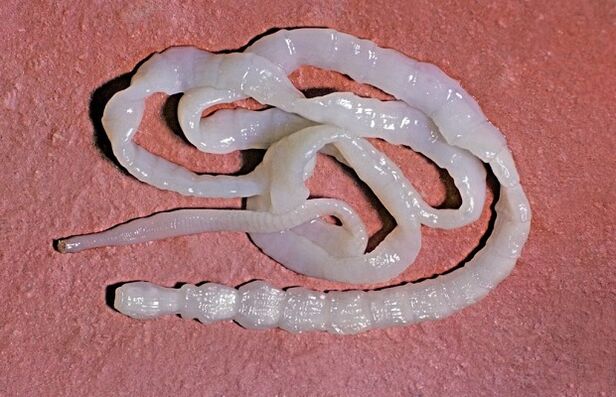
In addition, parasitic diseases are caused by protozoa (protists) - single-celled organisms; in the human intestine, Giardia or amoeba parasitize.
Illnesses caused by parasites in children present different degrees of danger but have similar symptoms. The vast majority of roundworms parasitize in the gastrointestinal tract, they are found in the contents of the duodenum, in the feces. The source of nutrition for worms is digested food (most often carbohydrates), sometimes blood. Helminthiases in children have symptoms similar to an eating disorder or gastrointestinal disease.
The most common types of helminthiases in children
Children are much more prone to worm infestations than adults. The most common helminthiases in children:
- Enterobiasis (worm infection).
- Ascariasis (ascaris invasion).
- Giardiasis (giardia invasion).
Pinworms live only in the intestines. The migratory roundworm larvae enter the respiratory tract, liver and heart. Giardia often causes liver and gallbladder disease, although they are not able to survive within these organs. Are these diseases contagious?
Enterobiasis is transmitted from person to person by handshake, contact with household items used by the patient.
Ascariasis and giardiasis, under certain conditions, can also be passed from baby to other family members.
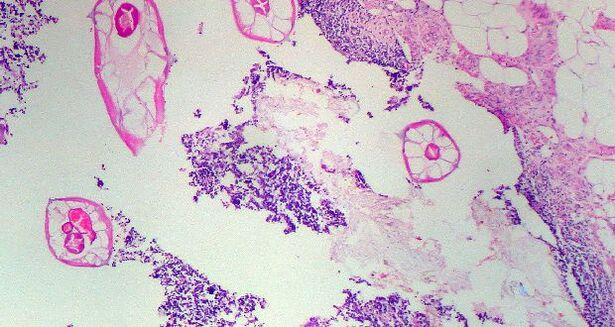
enterobiasis
The main cause of pinworm infection is dirty hands. In addition, the eggs of the parasite can enter the baby's body when eating poorly washed fruit. Signs of worm infection appear after 3-4 weeks from the date of infection. A characteristic sign of enterobiasis is itching in the anal region, which appears during sleep. Unpleasant sensations are caused by the movement of female worms, which crawl to lay eggs. With a strong invasion, you can see the worms in a child's feces with the naked eye.
When the baby scratches the anus and then the hands go into the mouth (which is often the case with young children), reinfection occurs. Therefore, during the period of helminthiasis treatment, children should be monitored so that they wash their hands regularly and eat only well-processed foods.
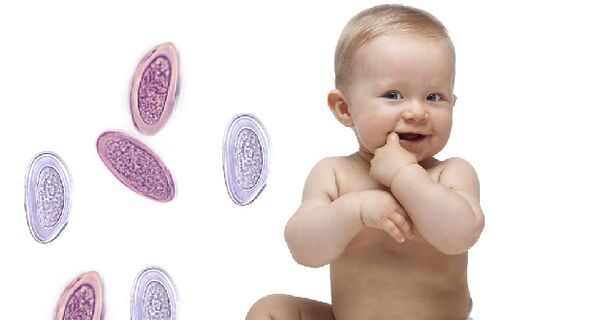
ascariasis
Roundworm infection occurs through unwashed, insufficiently heat-processed meat, through contact with animals. The parasites enter the baby's body in the form of eggs and larvae. Eggs develop in the intestines, larvae begin to migrate through blood and lymph channels. They reach the liver, right ventricle of the heart, lungs. These organs are regularly and abundantly supplied with oxygen, which is so necessary for larvae to develop into adults. From the lungs, the larvae enter the bronchi, trachea, cough and are swallowed with saliva in the stomach. The cycle of movements continues until the larva grows.
With worms in children, in addition to the typical symptoms, an intense cough may appear. Helminthiasis in children is detected using a coprogram and specific blood tests.
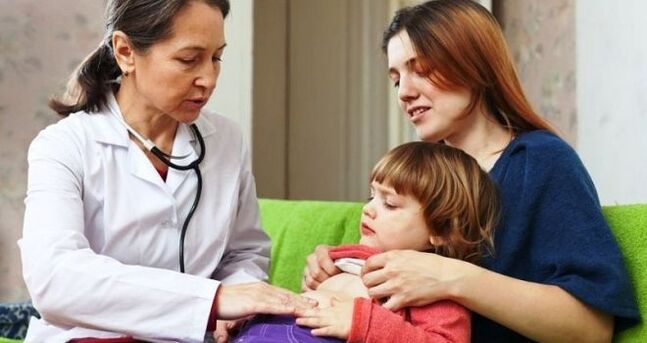
giardiasis
Giardiasis in a child develops when more than 10 cysts enter the body. Cysts are immobile, resistant to environmental conditions, the form of existence of the lamblia from which, under favorable conditions, individuals capable of reproducing develop. Motile protists can only live in conditions created only in the human small intestine.
Developmental stages of Giardia invasion in humans:
- Oral cavity cysts enter the stomach and then the duodenum. The protective capsule is destroyed, two Giardia are released.
- Giardia eat simple carbohydrates, multiply by longitudinally dividing the cell in half.
- Some of the parasites pass into the large intestine, where they can exist only in the form of cysts.
- During the act of defecating, the cysts come out, entering the external environment.
Giardia cysts can be found in water, vegetables, fruits, meat, household surfaces. They are very tenacious, they are difficult to destroy with conventional detergents. The risk of human-to-human transmission is low.
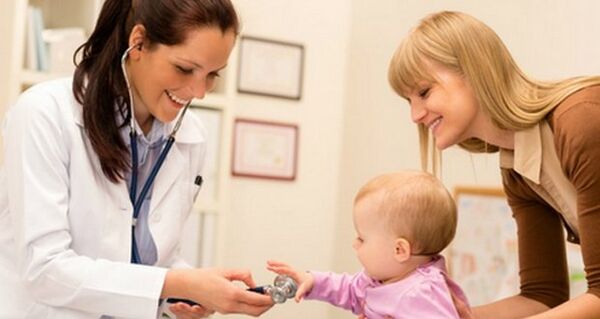
Typical symptoms of helminthiasis in children
The first signs of worms appear 2-4 weeks after infection. Worm infestation in children can be acute or latent. If the parasite population is small, the baby may not experience any discomfort.
The main symptoms of worms in children:
- Pain in the abdomen of different location and intensity, manifested by convulsions.
- Stool disorders, diarrhea and constipation.
- Nausea, vomiting.
- Reduced appetite or, conversely, brutal.
- Intestinal dysbacteriosis.
- Loss of energy, dizziness.
- Sleep disorders.
- Dermatitis.
- Pale skin, blue circles under eyes.
- Girls can develop urinary incontinence.
Dermatitis (rash, redness, itchy skin) is the result of an allergic reaction to the toxins that helminths release. Harmful substances also affect the state of the nervous system. Children look tired, become irritable, capricious.
Acute infection is accompanied by symptoms of helminths in children - fever, vomiting, diarrhea.
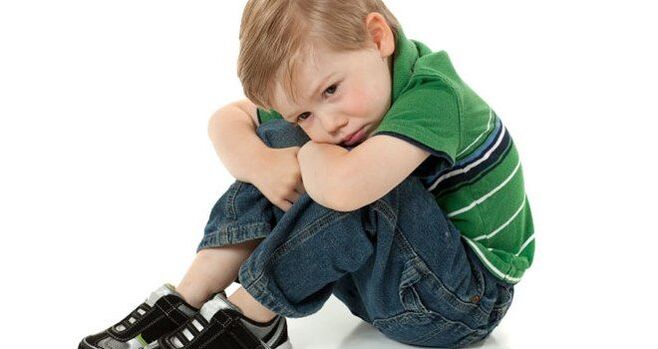
Tests for helminths in children
How to identify worms in a child? Worm infestations in children are difficult to determine from the clinical picture. The symptoms of different helminthiases are similar to each other. The detection of worms is carried out with the help of time-tested methods and new laboratory diagnostic methods.
- The histological analysis of the feces allows verifying the presence of helminth eggs in the feces.
- Microscopic examination of scrapings from the anus (helps to recognize enterobiasis).
- Analysis of the contents of the duodenum. In the duodenal contents, worms or protozoa can be found.
- General blood test with leukocyte formula. Indirect signs of the presence of worms are an increased level of eosinophils and anemia.
- Serological tests for antibodies to helminth antigens.
- Polymerase chain reaction (PCR) analysis.
PCR is the most reliable and sensitive method for diagnosing helminthic invasions. Blood, feces, scrapings are suitable for analysis. The study determines the presence of foreign DNA in a biological sample. The efficiency of the histological coprogram is lower than that of PCR and ELISA.

Principles of treatment of helminthic invasions
How to get rid of worms in children? The treatment method depends on the type and degree of helminthic invasion. Typically, helminthiases are treated conservatively (without surgery), but an operation is performed to remove the echinococcal cysts.
The treatment of worms in children consists of several steps:
- Preparing the body for treatment.
- Actually therapy, taking anthelmintic drugs.
- Body recovery after illness and medication. It is necessary to normalize the functioning of the nervous system, increase immunity, get rid of intestinal dysbacteriosis.
Typically, the treatment period takes about three months. Before starting therapy, you need to accurately determine whether the child has worms. Treatment is prescribed and controlled by a doctor.

Drug therapy of helminthiasis in children
An integrated approach will help to completely cure any variety of helminthiases, without harming the body. You can treat worms in a child using certain medications:
- Anthelmintic drugs. They include antiparasitic drugs that differ in spectrum and principle of action. Named depending on the type of invasion. It will be more convenient for the baby to take the drug in suspension form.
- sorbents. Bind toxins, accelerate the elimination of worms from the body. Only strictly defined doses of sorbents can be taken, otherwise serious digestive disorders may occur.
- Antiallergic agents. Helps relieve symptoms of helminth residue allergies.
- Hepatoprotectors. Assign during the recovery period. It helps to normalize the functioning of the liver.
- enzyme preparations. Restore normal digestion.
In the treatment of enterobiasis, the patient is also prescribed enemas. If the baby is prone to constipation, the doctor will prescribe baby laxatives. It is important to provide regular stools so that parasites and toxins are eliminated from the body. It is impossible to take any medication uncontrollably as there is a possibility of side effects.
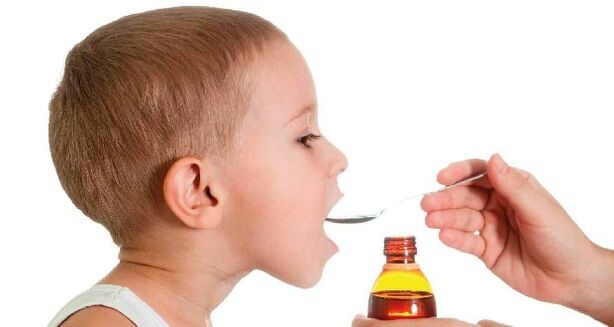
Traditional medicine for worms
Traditional medicine is not desirable for the treatment of helminthiasis in children. They do not kill the worms and do not help to remove them from the body. Folk remedies can only be used in combination with drug treatment.
How to remove worms from a child with folk methods? There are some of the most common recipes:
- Pumpkin seed. Contains components that interfere with the normal functioning of worms, remove toxins. Peeled seeds (100 g) are crushed and poured with oil (100 ml). The tincture is given to the child before meals (three hours) for three days. The treatment is repeated after 2 days. Pumpkin seeds can be boiled in milk (15 seeds in 1 cup). The medicine is given to drink to the baby before lunch.
- Garlic mix. A few cloves of garlic (2-3) should be rubbed on a fine grater, mixed with a small amount of water until smooth. For a small child, garlic porridge is mixed with a spoonful of milk or orange juice, given to drink before bed.
- Onion in oil. 100 grams of onions are chopped, covered with a teaspoon of salt, poured with 50 ml of sunflower or olive oil. The mixture is given to the baby for five days in a row before going to bed.

Carrot and beetroot juice, echinacea tincture will help to increase the child's immunity. Restore the nervous system - Chamomile tea. Chamomile is also used for enemas for enterobiasis.
Folk remedies are contraindicated in children with peptic ulcer, gastritis, pancreatitis, a tendency to allergies. And, of course, before you start testing "grandmother's recipes" on a child, first consult a pediatrician and a parasitologist, otherwise the result of such therapy can be the most unpredictable.
Dietary supplements and homeopathy for worms
The internet is full of advertisements for biologically active additives (BAA) and homeopathic remedies, which, according to the manufacturers, will completely remove the worms. Reviews of the funds are extremely positive.
Why can't dietary supplements be used to treat worms in a child? Biologically active food supplements help to normalize metabolism, increase the body's resistance, improve the functioning of internal organs, but do not get rid of parasites. They can only be used in combination with traditional medicines.
Homeopathic preparations consist of a complex of natural extracts. They also do not have a harmful effect on worms. But they can increase immunity, restore metabolism. In many countries today it is forbidden to prescribe homeopathic medicines due to their ineffectiveness.

Prevention of helminthiasis in children
Prevention of the appearance of helminthiases in children includes simple measures:
- Hygiene. Parents should ensure that the child regularly washes his hands, takes a bath or shower, does not bite his nails, does not put toys in his mouth.
- Sufficient heat treatment of meat and fish.
- Regular scraping for enterobiosis (this procedure is carried out in kindergarten).
- Healthy sleep, observance of daily routine.
- Balanced diet.
- Taking vitamins.
Drug prophylaxis should be carried out if cases of infection are recorded in a kindergarten or school, one of the family members or a pet has contracted the infection.
Symptoms of helminths in children are easily confused with manifestations of food poisoning, diseases of the gastrointestinal tract. How to find out if a child has worms, the doctor will tell you. Children can be treated for worms after an accurate diagnosis is made under the strict supervision of a specialist. Caring parents must understand that the health of young children is completely in their hands.






































